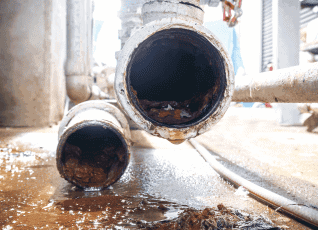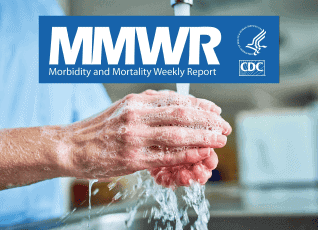Controlling Legionella pneumophila in Water Systems at Reduced Hot Water Temperatures with Copper and Silver Ionization
ELAINE CLOUTMAN-GREEN, VERA L BARBOSA, DIEGO JIMENEZ, DANIEL WONG, HELEN DUNN, BRIAN NEEDHAM, LENA CIRIC, JOHN C HARTLEYELSEVIER, AMERICAN JOURNAL OF INFECTION CONTROL, JANUARY 2019 IntroductionThis study was conducted at a newly built healthcare facility in the United Kingdom. There, the Department of Health recommends maintaining hot water temperatures above 131o F (55o C) to control Legionella in water supply systems. The goal of this study was to determine the efficacy of copper-silver ionization to control Legionella at deliberately reduced hot water temperatures in a newly-constructed healthcare facility. ResultsThe results of routine monthly sampling (1,598 total) from 2011 to 2017 demonstrated effective (100%) Legionella control with an average hot water temperature of 107.6°F (42°C). The facility experienced a 33% reduction in energy usage and a 24% reduction in carbon emissions. ConclusionThis study showed that the spread of Legionella could be controlled at reduced hot water temperatures, but interventions were required to maintain adequate levels of copper and silver. Full report
Use of Copper-Silver Ionization for the Control of Legionella in Alkaline Environments at Healthcare Facilities
DAVID M. DZIEWULSKI, ERIN INGLES, NECULAI CODRU, JOHN STREPELIS, DIANNA SCHOONMAKER-BOPPELSEVIER, AMERICAN JOURNAL OF INFECTION CONTROL, JULY 2015 IntroductionThis study examined two healthcare facilities using copper-silver ionization to control Legionella in alkaline water conditions. One facility was an acute care facility with a pH range of 8.7-9.9. The other was a long-term care facility with a pH range of 8.9-9.7. Both had previously used disinfection methods without success, including superheat-and-flush, hyperchlorination, and chlorine dioxide. ResultsAcute care facilityThe acute care facility reported six cases of Legionnaires’ disease before installing the copper-silver ionization system. After installation, the Legionella positivity rate (percentage of test sites within the building positive for Legionella) was reduced to 0%. Long-term care facilityThe long-term care facility reported two Legionnaires’ cases before installing the copper-silver ionization system. During the early stages of treatment, instabilities in both copper and silver concentrations occurred and were attributed to electrode scaling. This was followed by an increase in Legionella. Once ion concentrations were stabilized, the Legionella positivity rate was reduced to 0%. ConclusionCopper-silver ionization successfully controlled Legionella under alkaline water conditions but required frequent monitoring and system adjustments to maintain efficacy. The study found that alkaline water conditions reduce copper ion concentrations, however, the facilities were able to achieve non-detect as silver ions were less impacted and appeared to be the main ion controlling Legionella. Full study
Controlling Legionella Case Study: Chlorine Dioxide vs. Copper-Silver Ionization

In 2009, an outbreak of Legionnaire’s Disease hit a large Georgia hospital, affecting six wards, and resulting in the closure of 10% of their patient beds. After trying several solutions, including installation of continuous chlorine dioxide systems and plumbing infrastructure upgrades, the hospital still tested positive for Legionella. In 2023, the hospital partnered with LiquiTech to install a LiquiTech™ Copper-Silver Ionization System to control the Legionella contamination and reduce the risk of future disease outbreaks. Within just two months of installing copper-silver ionization, the Legionella positivity rate dropped from 100% to 11%, with the next round of testing showing 0% positivity. Through its ongoing service partnership with LiquiTech, the hospital has successfully maintained control of the Legionella contamination. By choosing the right technology and ensuring ongoing maintenance, the hospital’s priorities of protecting their staff and patients and controlling waterborne pathogens were achieved. To learn more, read the full case study here.
Sediment in Building Water Systems: How It Impacts Plumbing and Budget

Sediment in your building’s water system can cause damage to plumbing, increase maintenance costs, and promote bacterial growth. To ensure your building water system runs smoothly and efficiently, it’s crucial to understand what sediment is, how it enters your water system, and strategies to control it. Sediment in building water systems Sediment is a naturally occurring material that gets into source water from soil runoff or the breakdown of organic materials. It can get into a building’s water system from: Sediment’s impact on plumbing Too much sediment in a building’s water system can damage plumbing, increase operational costs, and reduce the life expectancy of equipment, including: Sediment’s impact on bacterial growth High sediment loads can encourage bacterial growth, increasing a facility’s risk of disease outbreak, like Legionnaire’s Disease. Three key ways sediment increases bacterial growth include: Benefits of controlling sediment in building water systems The benefits of controlling sediment in your building water system include: How to control sediment in building water systems There are several ways facilities can control sediment in their building water system, including: Sediment filtration case study A newly built facility in Colorado began experiencing issues with its plumbing infrastructure soon after opening its doors to patients in 2016, including: A sediment test by LiquiTech uncovered 26 times the World Health Organization-recommended sediment levels entering the building from the incoming water supply. Installing a new LiquiTech Sediment Filtration System removed 96.7% of incoming sediment, helping the facility: Installing a sediment filtration system is an effective way to control sediment, improve water quality, and extend the life of plumbing equipment. It can also result in cost savings for facilities by reducing maintenance and equipment replacement costs. For more insights on controlling sediment in your building water system, contact us today. Our team of ASSE 12080 Certified Legionella Water Safety and Management Specialists can work with you to develop a solution that’s tailored to your specific needs.
CDC Report Links Cluster of Healthcare-Associated Infections to Water System

A report published in CDC’s Morbidity and Mortality Weekly Report on August 4, 2023 linked a cluster of healthcare-associated infections to an Idaho hospital’s potable water system. According to the report, two patients who stayed in the same ICU room four months apart were found to be infected with carbapenemase-producing carbapenem-resistant Pseudomonas aeruginosa (CP-CRPA). Carbapenem-resistant organisms, such as CRPA, are gram-negative bacteria resistant to the carbapenem class of antibiotics, a broad-spectrum antibiotic considered a “last resort.” Certain carbapenem-resistant organisms are resistant because they produce carbapenemase enzymes that make carbapenems ineffective. Infections from carbapenemase-producing organisms are difficult to treat and associated with high mortality. Pseudomonas aeruginosa can carry genes encoded with carbapenemases that can be transferred between strains and across bacterial species, leading to the spread of antibiotic resistance. CP-CRPA infections are typically transmitted from person-to-person or acquired from environmental sources, like water, sink drains, and toilets. Investigation and resultsA collaborative investigation involving the Idaho Division of Public Health, the Idaho Bureau of Laboratories, the Utah Public Health Laboratory, and the CDC was undertaken to identify the cause of the infection. The investigative team focused on the plumbing in the ICU room because Pseudomonas aeruginosa is known to persist in biofilm, a collection of microorganisms that adhere to one another and to a surface, such as a pipe. Water samples and swabs from two sinks and one toilet were collected. CP-CRPA with the same gene type isolated in the patients was found in one of the sinks, including swab samples from the drain, p-trap (a bend in a sink drain that holds water to block sewer gases), and sink counter. Water samples from the same sink’s p-trap and a toilet also tested positive for a different strain of CP-CRPA. Due to the genetic link between the patient isolate and sink isolate, the investigative team concluded that the most likely source of the outbreak was the ICU room sink. Prevention and control measuresUpon identifying the sink as the likely infection source, suggested measures for prevention and control were immediately instituted. These included the application of biofilm disinfectants, a screening regimen for future patients occupying the room, and a commitment towards forwarding any CP-CRPA isolates to public health laboratories for detailed molecular profiling, prevention, and control. On conducting a retest, no further CP-CRPA strains were detected in the environmental samples. As of December 2022, no additional CP-CRPA isolates have been reported by the hospital. These findings underpin the important relationship between biofilm, building water systems, and healthcare-associated infections. Long-term strategies to control and prevent biofilm in plumbing systems, such as through continuous disinfection of the entire building water system, are crucial to reducing healthcare-associated infections and ensuring patient safety. Read the full report. ReferencesCenters for Disease Control and Prevention. (2023). Carbapenemase-Producing Organisms (CPO). Carbapenemase-Producing Organisms (CPO) 2023 Case Definition | CDC Minnesota Department of Health. (2023). Carbapenem Resistant Pseudomonas aeruginosa (CRPA). Carbapenem Resistant Pseudomonas aeruginosa (CRPA) – MN Dept. of Health (state.mn.us) Centers for Disease Control and Prevention. (2023). Cluster of Carbapenemase-Producing Carbapenem-Resistant Pseudomonas aeruginosa Among Patients in an Adult Intensive Care Unit. Morbidity and Mortality Weekly Report | CDC
LiquiTech Joins the National Association of Manufacturers

LiquiTech, a leading chemical-free, sustainable water treatment solutions provider, proudly announces its membership with the esteemed National Association of Manufacturers (NAM). NAM, the nation’s most influential advocate for manufacturers, actively strengthens American manufacturing through policy advocacy, inspiring a new generation of talent, legal representation for manufacturers’ interests, performance-enhancing programs, and authoritative news coverage. “We are thrilled to join forces with the National Association of Manufacturers,” said Jack Berkery, President of LiquiTech. ” As a member of NAM, LiquiTech is now part of an extensive network of industry leaders, resources, and expertise, enabling us to enhance cutting-edge technologies, promote best practices, and actively shape the future of US manufacturing. This partnership reinforces our dedication to excellence and aligns perfectly with our mission of delivering sustainable and chemical-free water treatment solutions.” Through this membership, LiquiTech is poised to play an integral role in shaping the future of the water treatment industry. By leveraging their expertise and unique offerings, LiquiTech aims to spearhead initiatives that enhance water quality, prolong the lifespan of water-bearing equipment, and generate long-term value for customers, businesses, and the environment.
LiquiTech’s Loan VanAuker Chosen as Ambassador for Prestigious This is Public Health Program

LiquiTech, the leading provider of chemical-free and sustainable water treatment solutions, is pleased to announce that the Association of Schools and Programs of Public Health (ASPPH) has chosen Loan VanAuker as an ambassador for their prestigious This is Public Health program for the 2023-2024 term. VanAuker is an infection prevention and control epidemiologist at LiquiTech with more than 15 years of experience in public health, infection prevention and control, epidemiology, and investigations. ASPPH’s This is Public Health is an initiative that raises awareness about education and career options in public health through student ambassadors, graduate fairs, partnerships, interprofessional activities, and other pipeline-building events for students.As an ambassador, VanAuker will play a crucial role in leading virtual events and collaborating on projects and presentations to engage individuals and inspire them to pursue careers in public health. Her focus on water safety and copper-silver ionization education underscores the critical role these areas play in preventing waterborne illnesses and ensuring public health. VanAuker expressed her excitement about the opportunity, stating, “I am honored to be chosen as an ambassador for This is Public Health. At LiquiTech, we are committed to advancing water safety, and this platform allows me to amplify our efforts and promote the importance of public health education. I am eager to contribute to the growing interest in this field and positively impact the well-being of communities nationwide.” About LiquiTechLiquiTech partners with businesses to provide chemical-free, sustainable water treatment solutions that improve water quality, extend the life of water-bearing equipment, and deliver long-term value to their customers, their businesses, and the planet.
What is a Water Management Program?

Building water systems can create perfect conditions for Legionella and other waterborne pathogens to multiply and cause disease. Some factors in building water systems contributing to Legionella and pathogen growth include water stagnation, lack of disinfectant, water temperatures, and sediment. A water management program works to pinpoint potential hazards within the water system, so controls can be put in place to prevent pathogens from growing and spreading. Water management programs are now an industry standard for many buildings in the United States and are necessary to comply with various regulatory agencies, including The Joint Commission, ASHRAE Standard 188, Centers for Medicare & Medicaid Services, CDC, Veteran Affairs, Department of Defense, and others. Steps of a water management program Developing and maintaining a water management program is a multi-step process that requires continuous review and examination. Several components or steps are necessary to create a well-rounded water management program. Elements of successful water management programs The key elements of a successful water management program include: Customizing water management programs for each building Water management programs should be tailored to your unique building(s). Factors to consider include: For some facilities, like hospitals, hotels, and other large facilities with complex water systems, a water management program should be developed for the entire building. For smaller buildings with simple water systems, a water management program may only be necessary for specific areas or equipment, like cooling towers or decorative fountains. No two water management programs are the same, and your organization’s unique goals, needs, and buildings must play a role in how the water management program is developed and implemented. Partnering with an experienced water management company like LiquiTech can simplify the process of developing and implementing a compliant water management program. Learn more about LiquiTech’s water management programs.
Why Legionella Testing is Essential for Building Owners

An essential part of building ownership is ensuring your drinking water is safe. This includes having an active water management program and conducting regular testing for Legionella bacteria. What is Legionella? Legionella is a type of bacteria that can grow in your building’s water system. Legionella is pathogenic, meaning that exposure to it can cause disease. It is especially harmful to seniors and immunocompromised individuals, causing a severe type of pneumonia called Legionnaires’ disease. Why is regular Legionella testing important? You should regularly conduct water quality tests if you own a multi-story building that could expose people to Legionella. Timely identification of Legionella in your building water system allows you to begin remediation efforts quickly, potentially stopping an outbreak of Legionnaire’s disease before it occurs. While Legionella poses a threat wherever it may grow, certain types of facilities may benefit more from routine testing, including: In addition, some facilities are required to conduct routine Legionella testing by their state or local government or other regulatory agencies. Types of Legionella water tests Several types of water tests can identify Legionella. Some test methods may be performed onsite by facility staff, while others may require working with a certified laboratory. Regardless of the test method, it’s important to understand the process and limitations of each. Standard lab culture Lab qPCR Alternative methods (e.g., on-site rapid tests) For facilities that serve people who are immunocompromised or over 55, like senior communities, nursing homes, and hospitals, regular Legionella testing is a critical piece of your overall water management program and crucial to your facility’s ability to provide a safe and healthy environment for occupants.
Benefits of UV Disinfection Water Treatment

According to the EPA, more than 90 contaminants may be present in drinking water. UV light water treatment can eliminate up to 99.99% of the microbial contaminants commonly found in water. It does not require the use of chemicals and does not produce harmful byproducts. This blog post will explore the benefits of UV light water treatment. We’ll look at its efficiency, low maintenance, and cost-effectiveness. We will also discuss how UV disinfection works and why it is an ideal solution for businesses seeking a safe and reliable water treatment method. How UV disinfection works UV disinfection uses ultraviolet light to eliminate harmful microorganisms from water. UV light damages the DNA of the microorganisms, making it impossible for them to reproduce or cause harm. It works by passing water through a chamber where it is exposed to UV light generated by special lamps. The UV light used in disinfection systems is in the range of 254 nanometers in wavelength. This effectively destroys a wide range of microorganisms, including cysts, viruses, and bacteria. Benefits of UV light water treatment UV light water treatment has become popular for businesses that require effective and efficient water treatment methods. One of the main reasons for this popularity is its many benefits. Chemical-free and eco-friendly UV disinfection does not require using chemicals and does not produce any harmful byproducts. This makes it an eco-friendly solution safe for the environment and human health. Effective Well-designed UV water treatment systems can eliminate up to 99.99% of microorganisms. A common problem with UV disinfection systems is shadowing – areas where particles in the water block the UV light. Any microorganisms in the shaded area are protected. To avoid shadowing, look for UV disinfection systems that expose the water to intense UV light from 360 degrees. Low maintenance UV disinfection systems can be low maintenance and easy to manage. Look for self-cleaning systems that automatically remove minerals and deposit buildup. This ensures optimal operation and minimal maintenance from staff. Another important consideration is a system that does not require disassembly to change lamps. This makes lamp changes quick, easy, and safe. Low operating cost Compared to other water disinfection systems, UV has the lowest operating cost. A small amount of electricity is needed to power the UV lamps. Aside from the cost of replacement lamps, most systems require minimal maintenance time and investment over their lifetime. Fast UV disinfection works instantly as the water is exposed to UV light. This makes it one of the fastest water disinfection methods available. Compact Most UV water treatment systems are compact and take up minimal space in crowded mechanical rooms, making them an excellent retrofit solution for existing facilities. Choose UV light water treatment for safe water The benefits of UV disinfection water treatment for businesses are clear. Well-designed UV systems can be an effective, efficient, and cost-effective disinfection method. Whether in the food and beverage industry, hospitality, healthcare, or any other business requiring high-quality water treatment, UV light disinfection is a smart choice. Learn more about UV disinfection systems for your business: https://liquitech.com/products/uv-disinfection/